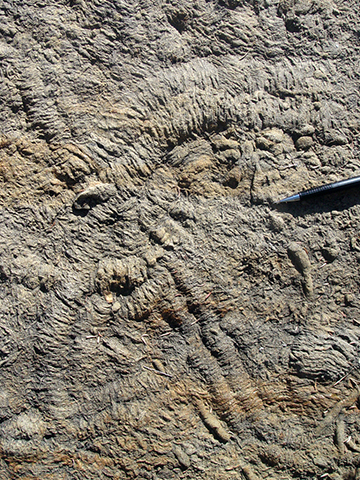Part B
What Are Fossils?
The word fossil (Latin for "dug up") is a commonly used word in our language. Geologists define a fossil as the naturally preserved remains or traces of animals or plants that lived in the geologic past. Thus, a fossil must be a former life form (like seaweed or dinosaurs), and it had to live in the geologic past, which is an ambiguous amount of time representing anywhere from thousands to billions of years. It also must preserved by natural processes, so mummies or cryogenically frozen relatives do not count as fossils.
Paleontology is a field of study in geology that involves analysis and interpretation of fossils, and a paleontologist is one who undertakes this challenge. Fossils are important because they: 1) represent the existence and development of organisms that lived in the past, 2) can be indicators of the environment in which the original organism lived, and 3) are important in mapping and correlating rock units in the field. Although this class will not involve rigorous taxonomic classification and study of fossils, we will apply some basic aspects of paleontology to help understand life and geologic history.
|
Figure 6-4. Body fossils and trace fossils: direct and indirect evidence of life in the past. A body fossil of the trilobite Dicranus (left), and trilobite trace fossil tracks from the Cambrian Bright Angel Shale (right). |
|
Fossil Types
It's not all about shells and bones, as there are other valuable indicators that can yield information about creatures of the past and their behavior. These other features include trace fossils of various kinds, fossilized feces, and chemical residue of former organic life.
> Fossils where some or the entire original critter is preserved, although the original composition of an organism is typically changed through some alteration process.
> Tracks, trails, burrows, etc. that indirectly record the existence of an organism.
> Other types of trace fossils include molds and casts. An external mold is a hole or void formed when an object is pressed into soft sediment and then is removed (pulled out, decomposed, dissolved), leaving an impression of the outer surface of the object. A cast is a replica of the original object formed as secondary minerals fill the void left as the object dissolves away (during permineralization). Casts are relatively rare.
> Fossilized animal waste material. Study of the fossilized animal and plant material contained within coprolites can provide important clues about the diet and environment of ancient organisms.
> Complex organic compounds that can be traced to a source life form. Also known as biomarkers, biosignatures, or molecular fossils.
Fossilization Processes
Plant and animal material can be preserved in different ways, but the probability of preservation is increased if an organism contains durable hard parts (bones, teeth, a shell, etc.) than if it is made mostly of soft material (like jellyfish or most insects).
> A common process involving substitution of a new mineral (like calcite, dolomite, quartz, pyrite, etc.) for the original material. Petrified wood (Arizona's state fossil) is an example of replacement and permineralization.
Recrystallization
> Conversion of some minerals into more stable forms of the same (or similar minerals), possibly involving the loss of some details. The calcium carbonate mineral aragonite forms mollusc shells and coral, but changes to the more stable calcite over long periods of time.
> The precipitation of minerals, like calcite, dolomite, silica, pyrite, etc., in the open spaces within shells, bones, and tissue. The precipitating minerals typically have a composition different from that of the original shell or bone. This process results in the creation of an internal cast. Petrified wood is also an example of permineralization (and replacement).
> Chemical alteration of organic-rich material into a thin film of carbon. Plant material is commonly preserved in certain types of shale in this manner.
![]()
![]()
![]()
![]()
![]()

